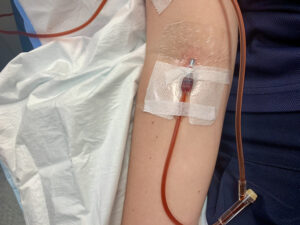Very few studies have examined how anemia management strategies affect post-hospitalization outcomes for critically ill patients. A recent randomized controlled trial at the Mayo Clinic hypothesized that a multifaceted anemia management approach would increase hemoglobin (Hb) values as well as post-hospitalization function and quality of life. During the study, 100 adult patients admitted to the intensive care unit (ICU) with moderate to severe anemia (median age, 68 years; 57% male; 76% surgical ICU; median Hb at enrollment, 8.9 g/dL) were randomized 1:1 to receive either a treatment bundle (n=49) or standard care (n=51). The treatment bundle consisted of (1) optimized phlebotomy practices (e.g., low-volume blood draws), (2) clinical decision support (e.g., reminders to minimize non-essential lab tests), and (3) 1000 mg of intravenous iron after study enrollment. While length of hospital stay was not significantly different between treatment arms, one month after discharge hemoglobin levels were significantly higher in the treatment bundle arm compared to the standard care arm (12.2 g/dL vs. 11.5 g/dL, respectively). In addition, RBC transfusions up to three months after discharge tended to be lower in the treatment arm—only one patient in the treatment arm required an RBC transfusion compared to six in the standard care arm. While this treatment bundle for anemia was well tolerated and efficacious up to three months after discharge, further research is needed to understand the effectiveness of each component in treating anemia.
References:
- Warner MA, Johnson ML, Hanson AC, Fortune E, et al. Practical Anemia Bundle and Hemoglobin Recovery in Critical Illness: A Randomized Clinical Trial. JAMA Netw Open.2025;8(3):e252353.
- Walsh TS. Active Prevention and Treatment of Post–Critical Illness Anemia—Is It Time for Large Effectiveness Trials? JAMA Netw Open.2025;8(3):e252368.

